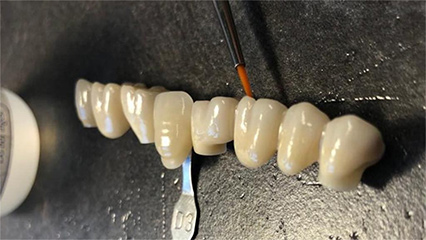Is zirconia prone to cracking?
2024-08-15
Zirconia, particularly in the context of dental restorations, is highly regarded for its exceptional strength and durability. When considering materials for dental crowns, one common concern among both patients and practitioners is the potential for cracking or chipping. This concern leads to the question: Is zirconia prone to cracking?
To answer this question, it's essential to understand the nature of zirconia and how it compares to other materials used in dental restorations.
What is Zirconia?

Zirconia, scientifically known as zirconium dioxide, is a crystalline oxide of zirconium. It is a ceramic material, but what sets it apart from other ceramics is its unique tetragonal crystal structure. This structure gives zirconia its remarkable toughness and resistance to fracture. The material undergoes a process called "transformation toughening" when subjected to stress, which enhances its strength. In this process, the zirconia crystals undergo a phase transformation that helps to close any cracks that may start to form, preventing them from propagating and causing the material to fail.
The Durability of Zirconia in Dental Applications
Zirconia is widely used in dentistry, particularly for dental crowns, bridges, and implants, due to its impressive mechanical properties. Unlike traditional ceramics, which can be brittle and prone to cracking under stress, zirconia is much more robust. Its high fracture toughness means that it can absorb significant amounts of stress without breaking. This makes zirconia an ideal material for areas of the mouth that experience heavy chewing forces, such as molars.
Dental zirconia is often praised for its ability to withstand the wear and tear of daily use. Whether it’s biting down on hard foods or enduring the constant pressure from chewing, zirconia crowns and bridges are designed to last for many years without cracking or chipping. This durability is one of the reasons why zirconia has become a preferred material among dentists and patients alike.
Comparing Zirconia to Other Dental Materials
When comparing zirconia to other dental materials, such as porcelain-fused-to-metal (PFM) crowns or all-ceramic crowns, zirconia clearly stands out in terms of durability. PFM crowns, while strong, rely on a metal substructure to provide support, and the overlying porcelain can sometimes chip or crack, especially if the metal beneath is exposed. All-ceramic crowns, on the other hand, while aesthetically pleasing, are generally more prone to cracking compared to zirconia, especially in areas of high stress.
Zirconia crowns do not require a metal substructure, yet they offer superior strength. The material is biocompatible, meaning it is well-tolerated by the body and unlikely to cause any adverse reactions. This biocompatibility, combined with its strength, makes zirconia an excellent choice for dental restorations.
Factors Affecting the Strength of Zirconia
While zirconia is exceptionally strong, several factors can influence its performance in dental applications. These include:
1.Quality of the Material: Not all zirconia is created equal. High-quality zirconia, which is carefully manufactured and processed, will have fewer flaws and better mechanical properties, reducing the likelihood of cracking.
2.Thickness of the Restoration: The thickness of a zirconia crown or bridge can also impact its strength. Thicker restorations generally offer more durability, although they may require more tooth reduction.
3.Proper Fabrication and Placement: The way a zirconia restoration is fabricated and placed in the mouth can affect its longevity. Precision in the milling process and careful handling during placement are crucial to ensuring that the restoration performs as expected.
4.Patient Habits: While zirconia is tough, extreme forces, such as those from bruxism (teeth grinding), can potentially cause damage over time. In such cases, patients may be advised to use a night guard to protect their restorations.
The Role of Transformation Toughening
One of the key reasons why zirconia is not prone to cracking is its ability to undergo transformation toughening. This process is a form of phase transformation that occurs at the microscopic level. When a crack starts to form in zirconia, the material undergoes a phase change from a tetragonal crystal structure to a monoclinic structure. This change results in an increase in volume, which effectively "closes" the crack and prevents it from growing. This self-healing property is unique to zirconia and is a significant factor in its high fracture resistance.
Clinical Evidence Supporting Zirconia’s Durability
Numerous clinical studies have demonstrated the long-term success of zirconia restorations. Research shows that zirconia crowns and bridges have excellent survival rates, with minimal incidences of cracking or chipping even after many years of use. This body of evidence reinforces the confidence that dental professionals have in zirconia as a reliable material for various restorative applications.
Conclusion: Is Zirconia Prone to Cracking?
In summary, zirconia is not prone to cracking, thanks to its unique properties and the way it is engineered. Its high fracture toughness, transformation toughening capability, and durability make it one of the strongest materials available for dental restorations. While no material is entirely immune to damage, zirconia offers a level of reliability and strength that few other materials can match. For patients seeking a long-lasting, resilient solution for dental crowns, bridges, or implants, zirconia is an excellent choice that provides peace of mind and enduring performance.
Medical Disclaimer: This article is for informational purposes only and is not intended to replace professional medical advice. Users are advised to consult their dentist or other professional medical provider before making any health or medical decisions.


